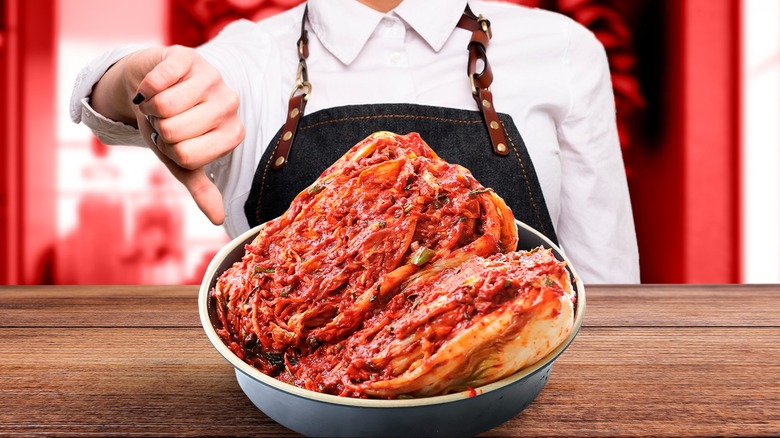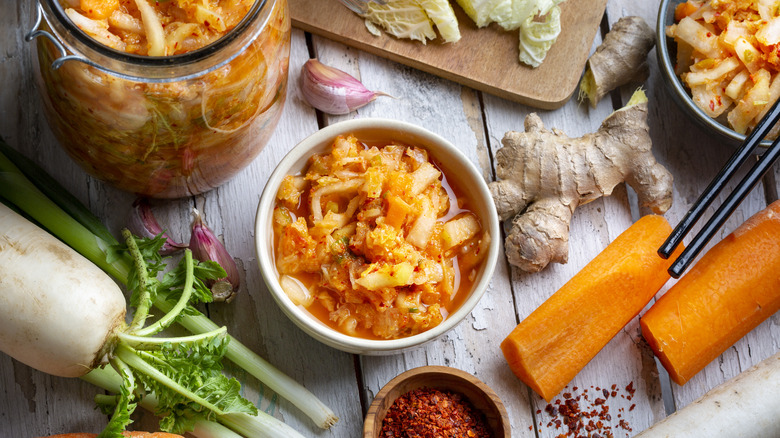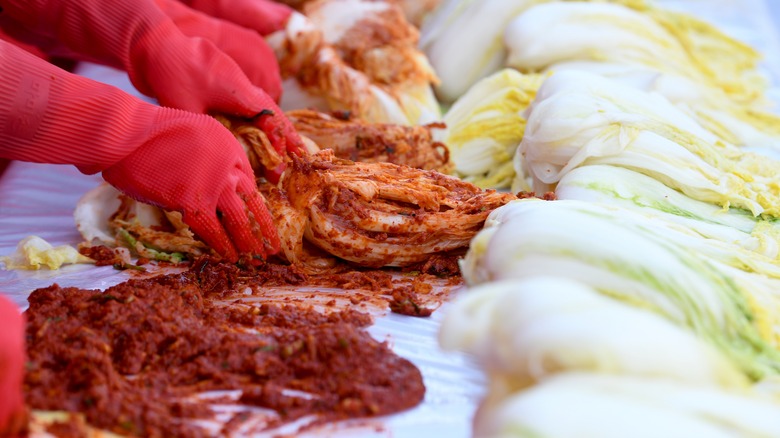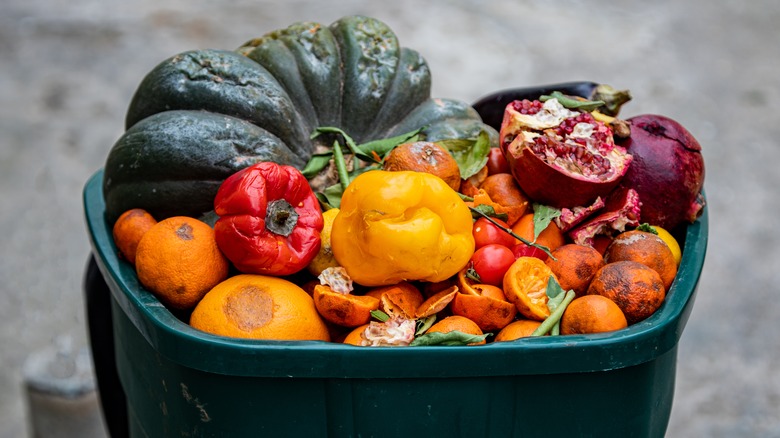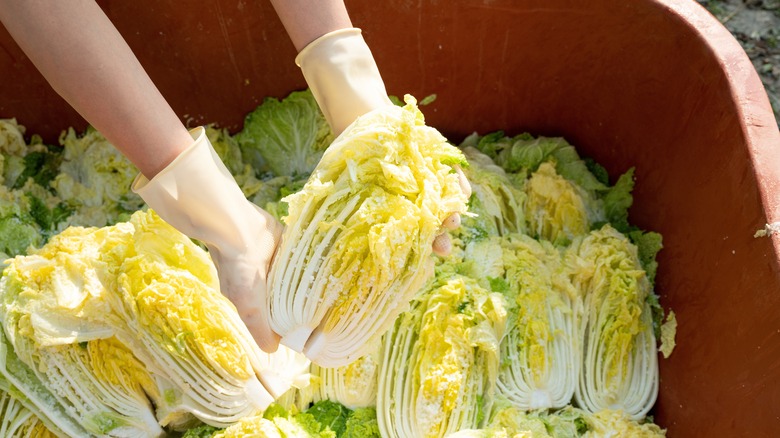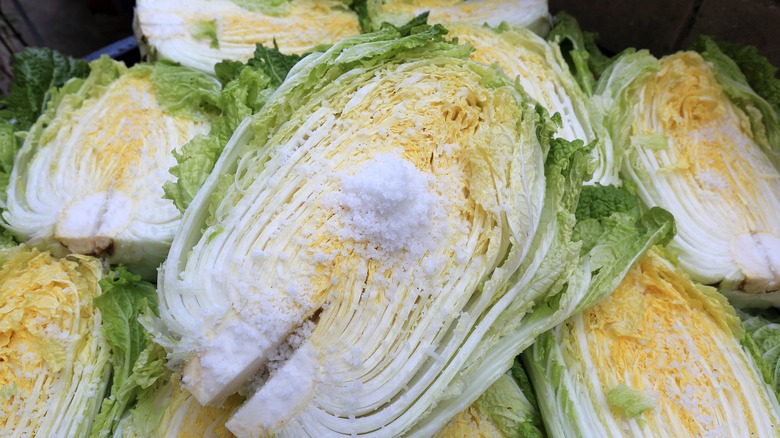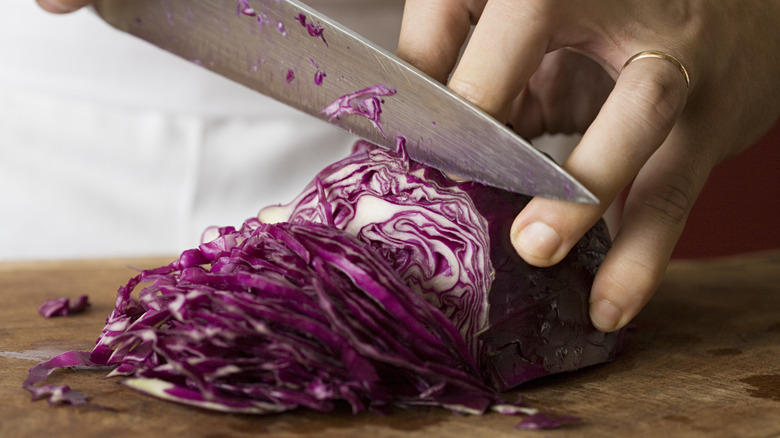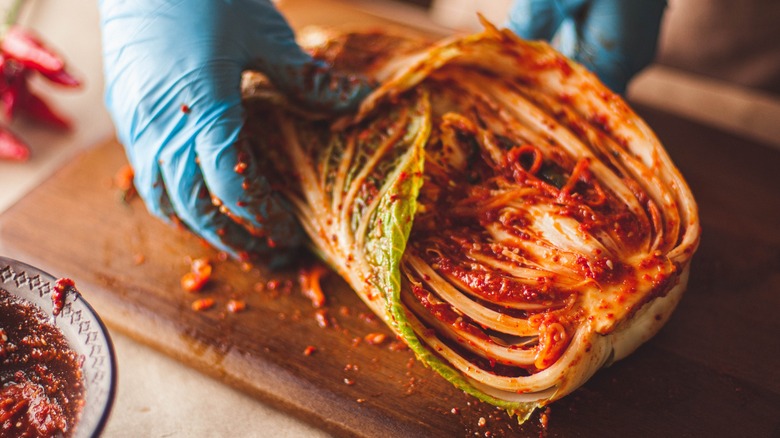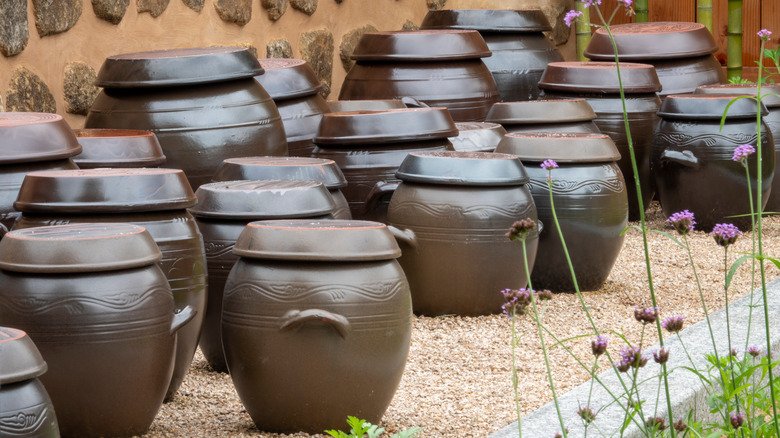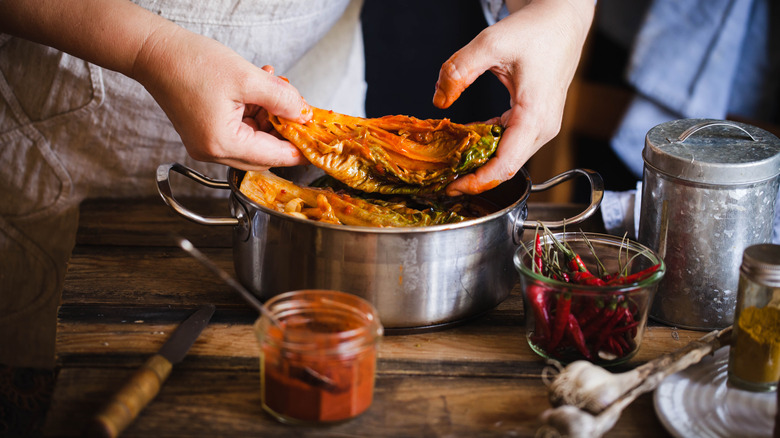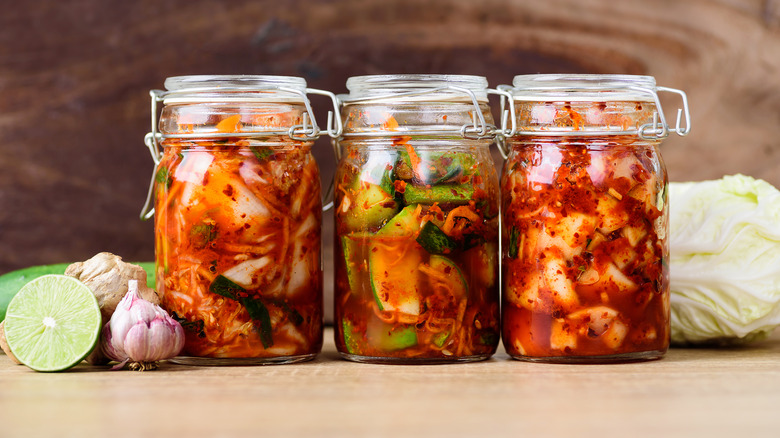12 Mistakes You Must Avoid When Making Kimchi
There's nothing wrong with store-bought kimchi. As the fermented Korean side dish snowballs in popularity across the world, kimchi is becoming ever more common on Western shelves and in recipes, like kimchi mac and cheese. But maybe you're unsatisfied with what you can find. Or maybe you're a curious cook looking to venture into a new fermentation product. Maybe you've tried your hand at making your own kimchi already, but your work fell flat (or worse, went horribly wrong). Whatever the case, you're in the right place.
We've gone through the napa cabbage-layered ringer plenty of times, so you don't have to — or at least, not as many times as we have. This guide is not so much a "how-to" as it is a "how-to-not." Kimchi can be made (and eaten) a multitude of different ways, depending on regional styles, traditions, produce available, and dietary restrictions. We don't suggest that this guide will tell you the only right way to make a delicious crock of kimchi. Rather, we hope it will guide you away from the 12 most common mistakes made by those new to the practice.
Whatever your experience level and fermentation background, making kimchi is like watching a child grow up: it's exciting and beautiful, but it can be an arduous road filled with screw-ups and lessons learned along the way. Let us guide you through making your crunchiest, funkiest, spiciest, and most delicious batch yet.
Using store-bought kimchi paste
There are plenty of brands offering pre-made kimchi paste that can be used to make kimchi at home. But, if you're going through the trouble of making kimchi at home, why not go all the way and make your own kimchi paste as well? One of the primary advantages of making your kimchi paste fresh is the ability to tailor the flavors to suit your taste preferences. You gain full control over the spice level, sweetness, and other nuances, putting customization into your hands.
There is also the issue of freshness. Though kimchi, in its final form, is fermented, many of the ingredients in kimchi paste are aromatics — herbs, spices, and vegetables that release their essential oils, creating a depth of flavor and aroma. Using high-quality, fresh ingredients ensures a superior taste and a more vibrant final product. The comparison of pre-made kimchi to homemade kimchi is similar to that of pre-minced garlic to garlic cloves you peel and chop yourself. Some store-bought pastes and kimchis may contain preservatives or additives, so making your own will lend itself to a more natural fermentation of your produce.
Finally, making your own kimchi paste will allow you to customize your kimchi to adhere to dietary restrictions. Making vegan kimchi for a friend? Leave fish sauce and anchovies out of the equation. Another friend can't handle spice? Use less gochujang and fresh chilis.
Buying low-quality ingredients for your kimchi paste
In the same way that using pre-made kimchi paste is a mediocre shortcut, so is using low-quality ingredients in your homemade paste. Think of it this way: Your kimchi will only be as good as the paste you make, and the paste you make will only be as good as the ingredients you use to make it. The flavor profile of kimchi is particularly susceptible to poor-quality ingredients. Subpar chili powder or spices, for example, may result in a bland or unbalanced taste, deviating from the authentic and robust flavors of traditional kimchi. Inferior ingredients can compromise the texture of the paste, leading to an unsatisfactory mouthfeel, especially if the garlic or ginger you use is less than fresh. Aromatics like garlic, ginger, and chilis are best when first harvested, bursting with moisture, pungent flavor, and strong odor. If your aromatics are off or your cheap fish sauce is full of sugar, your kimchi probably won't taste great either.
From a technical level, low-quality kimchi paste is bad for fermentation as well. Inadequate components may hinder the development of the characteristic tanginess and complexity that fermented kimchi is known for. They may also leave your kimchi vulnerable to unwanted microbes. Fermentation is all about the microbiome you promote in your vessel. If you throw some moldy ginger into the mix, you could inoculate your kimchi with the wrong kind of microorganisms and risk losing your entire batch.
Forgetting to taste your kimchi paste
One of the first things you learn in a professional kitchen is this mantra: taste everything. Without tasting every ingredient, and every derivative of it, how will you know whether what you're making is delicious? The same goes for making your ever-important kimchi paste: taste everything.
There is a bit of philosophy behind this: Tasting your ingredients (yes, all your ingredients) fosters a greater intimacy between you and your final product. Knowing how each component of a sauce or composed meal tastes on its own will allow you to better understand how everything works together to make up the greater whole. Take a small nibble of raw garlic. Dab a dollop of spicy gochujang onto your tongue. Nip a quarter teaspoon of dark brown fish sauce. What do you taste?
Once you know what you're working with a little better, follow your desired recipe to make your kimchi paste. Now, scoop a small bit of it onto your tongue. Spread it around your mouth to dilute it or lengthen the flavor like wine, seeing how long the flavor lasts. How does it taste? What does it need more of? If you don't know what your ingredients taste like, you won't be able to answer those questions. But if, instead, you have a visceral memory of wincing at the briny burst of umami from fish sauce, you might be able to tell if your kimchi paste is missing a bit of savory depth and salt.
Settling for low-quality produce
Remember the thing about not buying bad ingredients for your kimchi paste? The same sentiment goes for your produce. Whether you choose the classics like napa cabbage or daikon, or even something avant-garde like apples or collard greens, the quality of your ingredients is of the utmost importance. Healthy, ripe produce should be vibrant and exude the colors that the fruits and vegetables are naturally meant to. A healthy napa cabbage, for instance, will be bright green and white with turgid leaves that resist pressure and are full of moisture. Napa cabbage also has a microbiome of its own, full of wild cultures of good lactobacillus bacteria that will aid in its later fermentation.
As a rule of thumb, using low-quality ingredients yields a low-quality product. It is in your best interest to examine your produce carefully when shopping for ingredients for kimchi. Quality produce leads to more consistent results. It also ensures your food is richer in nutrients. Because fermentation enhances the bioavailability of certain nutrients and unlocks previously unavailable flavors in the produce, starting with nutrient-dense and healthy fruits or vegetables ensures a more nutritionally beneficial end result. If you start off fermenting veggies that have already started to decay, your kimchi might be, at best, less than appetizing, or at worst, dangerous to eat.
Not brining your produce
One of the most important steps in making kimchi is one of the first you will take: brining your produce. Kimchi-making, like other forms of lacto-fermentation, is done best with produce that is strong and crunchy, like cabbage and daikon. That is because this produce will hold its texture (and won't turn to mush) during the fermentation process, maintaining an appetizing crunch when ready to eat. That said, the produce needs to be prepared properly before it can be coated in kimchi paste and packed into a fermentation vessel.
Brining your produce for kimchi varies in process from vegetable to vegetable, fruit to fruit, but the basic idea is to lightly salt your cut produce, mix it, and allow the salt to penetrate. The salt in this step serves several integral purposes for your kimchi. First, by drawing out water and breaking down cell walls, the salt helps to soften the produce, making it more pliable and easier to work with. Brining also helps to preserve the produce by inhibiting the growth of harmful microorganisms and creating a favorable environment for lactobacillus, which thrives under slightly saline conditions. These bacteria produce lactic acid, which gives lacto-fermented food its signature tanginess.
If you skip brining, it's likely your kimchi will not ferment properly, and it could even mold or rot. If so, you could lose valuable time and product.
Over-salting your produce
Fermentation is a delicate process that requires a balanced environment for the right microorganisms to flourish. So, just as a lack of salt can lead to a bad batch of kimchi, so too can over-salting your produce. The first and most obvious consequence to over-salting during the brining process is that your produce will feel way too soft and taste unpleasantly salty, making the kimchi inedible. But at a more technical level, too much salt can also inhibit fermentation. There is a fine line between creating fermentation-friendly conditions and curing, which will kill off the bacteria necessary for fermentation.
Avoiding adding too much salt when brining your produce is as simple as measuring your salt by weight or volume before mixing it into your raw produce. Plenty of kimchi recipes specify the proper salt-to-produce ratios you can follow as well as the proper type of salt to use. As a rule of thumb, lacto-fermentation occurs most quickly under conditions of 1% to 2% salinity by weight. You can measure this by weighing the produce on a kitchen scale in grams and multiplying the weight by 0.01 to 0.02. The result is the amount of salt you should use in grams.
Cutting your produce the wrong size
As you may be able to tell by now, it's the little things that matter most in the process of making kimchi, and one of those little things is the size to which you cut your produce. Consistency is key here, as the size of your produce will ultimately affect the texture, flavor, and overall eating experience of your kimchi. As always, it's important to find a middle ground. There are a few questions you will want to ask yourself before making your first cuts: How long do you plan on fermenting your kimchi for, and how do you want it to taste?
Depending on your produce of choice, smaller pieces may ferment more quickly, potentially resulting in a kimchi that becomes overly tangy or sour if left to ferment for too long. Larger pieces may require more time to ferment thoroughly. If you want to ferment your kimchi for an extended period of time, consider cutting your produce a bit larger so that it will retain more texture throughout the fermentation process. That said, if the pieces are too large, the kimchi may have a chunkier and less uniform texture. But if the pieces are too small, the kimchi may become mushy or lose its crunch. Finding the right size cut for your ferment might take a few batches to get right, but tasting your kimchi occasionally throughout the fermentation process will help keep you in the loop.
Not using enough kimchi paste
There are few things more disappointing than underwhelming, flavorless kimchi. Oftentimes, this sad trait is a result of using too little kimchi paste. As we said before, your kimchi will only be as good as the paste you use. So it's important to use enough of it to impart the proper level of seasoning to your produce and to aid the fermentation process.
Think of the best kimchi you've had; how did it taste? Your answer likely involved adjectives like spicy, savory, tangy, complex, and maybe even a little sweet. All of these flavors are influenced, if not imparted completely, by kimchi paste. An inadequate amount of paste in kimchi usually means that the produce is under-seasoned. In other words, it tastes like it's missing something. Often, that feeling of emptiness usually indicates the need for more salt, which carries flavor in our food, and which, in kimchi, comes mostly from the paste.
Lacking in paste might also cause a lag in fermentation. The sugars and salt in kimchi paste aid in creating an environment conducive to the growth of beneficial bacteria. Insufficient paste may hinder the fermentation process, leading to a milder and less tangy kimchi. To avoid the tragedy of a flavorless kimchi, make sure you follow the guidelines in your recipe, if you're using one. Make sure you mix the paste thoroughly and evenly throughout the entirety of the produce, taste the coated produce before storing for fermentation, and adjust accordingly.
Relying on the wrong fermentation vessel
Think of your fermentation vessel — that is, what your kimchi will ferment in — as your mothership. You can't go flying through space with a hole in the hull. All the same, your fermentation vessel needs to be made of the right material, be the proper size and shape to fit your goods, and definitely be protective. Kimchi is traditionally fermented in large, earthenware containers called onggi. These crocks are made from porous clay, allowing air exchange during fermentation while maintaining an optimal environment for the growth of lactic acid bacteria.
The shape and size of the vessel can affect the distribution of the brine, paste, and produce, so it's important to choose the right size container for your needs as well as one that doesn't have many grooves or nooks. Proper fermentation also usually requires an airtight environment to prevent the entry of unwanted microorganisms. Using a vessel that doesn't seal well may expose the kimchi to contaminants and compromise the fermentation process.
You don't need traditional crocks to make good kimchi, though you might be able to find them for a reasonable price. In fact, you can make kimchi successfully in any container that is shaped evenly and can seal from the air, like a jar. To make kimchi in a jar, pack your kimchi into the vessel and press it down with a fermentation weight. Then close the jar with a lid that has an airlock attached.
Letting your ferment go unweighted
Fermentation is a rumbly and bubbly process. The bacteria that ferments the kimchi produces gas, which will bubble within the mixture and cause the kimchi to rise and expand. Without proper weight pressing down on the kimchi mixture during fermentation, the produce in the kimchi may not be evenly submerged in the brine liquid. Unsubmerged produce means that the kimchi is exposed to air, which can cause the kimchi to spoil or grow mold.
To avoid disaster, make sure that you pack and press your kimchi down into its fermentation vessel tightly, ensuring all of the produce is submerged in the brine. To keep it there, use a weight that is heavy and wide enough to keep all the produce under the surface. Many commercial crocks available are sold with their own proprietary fermentation weights that are designed to fit snugly within the container. But improvisation works well too! You could ostensibly use a heavy rock you found in a stream so long as you sanitize it properly before it goes into your kimchi.
Fermenting too long or not long enough
Fermentation time for kimchi is a critical factor that affects the taste, texture, and overall quality of the final product. Both fermenting too long and not fermenting long enough are sure-fire ways to end up with an unsatisfying batch of kimchi for several reasons. Forgetting about a batch of kimchi for too long will leave you with an over-fermented, overly sour, and mushy mess. Long bouts of fermentation means excess lactic acid, making the kimchi progressively tangier. Your taste preferences are your own, and you may particularly enjoy extra-sour kimchi, but leaving it for too long could make it unbearable. Worse, the kimchi might completely lose its texture as the bacteria break it down over time, resulting in sludge rather than a crispy, crunchy delight.
If you're too trigger-happy to get your kimchi off the shelf, you might end up with an underdeveloped kimchi that lacks flavor complexity and tastes too raw. Fermentation develops acidity and umami, but it takes time. If you don't let the kimchi do its thing, it could taste flavorless and immature. The bacteria may also not have had enough time to break down the produce, which will leave your kimchi tasting unfinished.
To strike the right balance in fermentation time, carefully taste your batch every few days. It's ultimately up to you to decide the flavor and texture of kimchi that's right for you.
Storing your final product incorrectly
Once your kimchi has reached optimal fermentation, you've got to store it properly to seal in its deliciousness. Refrigerating slows down the fermentation process so that the kimchi will retain a consistent flavor and texture and will not continue to break down as it would at room temperature. Make sure that whatever container you refrigerate your kimchi in is clean and airtight so that the food doesn't dry out or grow mold. You should also leaves enough headroom for gasses that might continue to release from the mixture.
Remember: Fermented food, unless pasteurized, remains alive even in the refrigerator (and for kimchi, not all growth is bad growth). It's also a good idea to label your kimchi with the date you harvested it and to check on your container regularly to ensure it hasn't spoiled in any way. Properly stored kimchi will stay fresh and good to eat in the refrigerator for months on end. If you're thinking in terms of years, keeping a stash of kimchi in the freezer isn't a bad call either.
